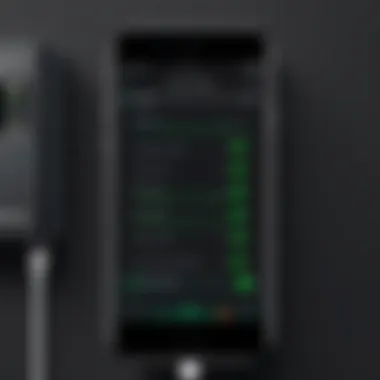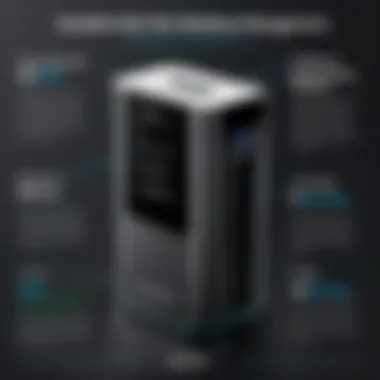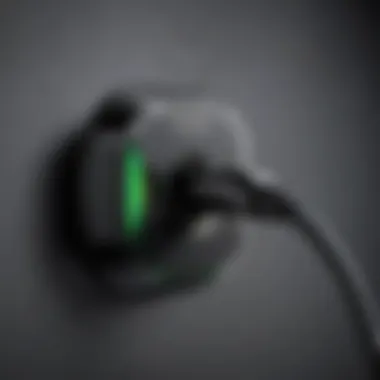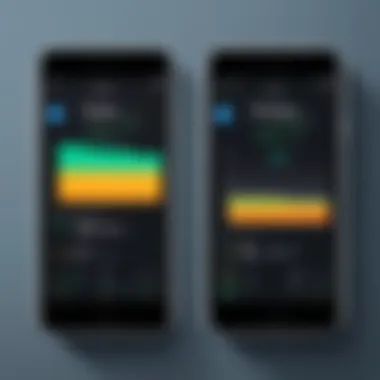Exploring Fast Battery Charger Apps: Features & Insights


Intro
In today's fast-paced digital world, battery life is a constant concern for users of smartphones and other portable devices. With increasing demands from applications, functionalities, and connectivity, the need for quick and efficient charging solutions has never been more pertinent. Super fast battery charger apps have emerged as a potential answer to this challenge, promising to enhance charging efficiency and prolong battery lifespan. This article delves into these applications, examining their principles, usage, and the various nuances that define their functionality and significance.
Understanding how these apps operate requires a look at both the hardware and software aspects involved in device charging. Hence, this exploration is segmented into key areas: an overview of the hardware that supports fast charging, followed by a meticulous analysis of the software solutions that facilitate faster battery charging. Each section will provide insights that are invaluable for IT professionals seeking to optimize device performance and user experience.
Prelims to Fast Charging Technology
Fast charging technology has changed the way we use mobile devices today. As device dependency increases, the importance of a quick charging solution becomes more apparent. This section lays the groundwork for understanding the intricacies of fast charging. By comprehending the core concepts, professionals can utilize technology better and choose appropriate tools.
Definition of Fast Charging
Fast charging refers to the ability of a device to recharge its battery at a higher rate than conventional charging methods. This technology employs various techniques that increase power output, reducing the overall charging time significantly. There are several standards and protocols, such as Qualcomm's Quick Charge and USB Power Delivery, which provide guidelines on how devices and chargers communicate to deliver rapid charging capabilities.
For a standard battery, this means converting electrical power efficiently while managing heat. Users can enjoy the convenience of a full battery in a fraction of the time, often achieving up to 80% charge in just 30 minutes. Notably, the effectiveness of fast charging can vary based on the device type, battery condition, and the charger used.
Evolution of Battery Technology
The evolution of battery technology has been pivotal in making fast charging a reality. Initially, batteries were bulkier and less efficient, often taking several hours to charge fully. Over time, significant advancements have led to the development of lithium-ion batteries, which are now standard in modern devices.
Some key points include:
- Enhanced Energy Density: Modern batteries can store more energy without increasing size or weight.
- Lower Internal Resistance: This allows for faster energy transfer, reducing charging times.
- Smart Charging Systems: Innovative algorithms manage charging, increasing speed while protecting battery health.
These advancements underscore the importance of ongoing research. As electronic devices continue to demand more power, the need for innovative charging solutions becomes crucial.
The Need for Battery Charger Apps
In today's fast-paced world, the reliance on mobile devices continues to escalate. With smartphones and tablets becoming essential tools for communication, work, and entertainment, the way these devices manage their power becomes critical. Battery charger apps have emerged as a response to this growing demand for efficient charging solutions. Such apps not only promise to speed up the charging process but also assist users in optimizing battery performance.
The relevance of these apps can be understood through several lenses, including user dependency, technological advancements, and the overall impact on device longevity.
Increasing Mobile Device Dependency
Mobile devices are at the center of modern life. Many people depend on their smartphones for everything from social interactions to business tasks. According to a study conducted by the Pew Research Center, over 85% of adults own a smartphone. This increased usage translates into more frequent charging sessions. As a result, having a reliable method for charging is crucial.
Battery charger apps address this issue by providing users with tools to enhance charging efficiency. They often include features such as
- Optimization algorithms that help control power usage during charging.
- Battery saving modes that adjust settings to prolong battery life during everyday use.
- Notifications that alert users when charging is complete or when to unplug the device to prevent overcharging.
Challenges in Battery Life Management
Despite advances in battery technology, managing battery life poses significant challenges. High-performance applications consume substantial power, leading to frequent charging cycles. This demand can accelerate battery degradation over time. It is essential to understand various factors that contribute to poor battery life. Some significant challenges include:
- Frequent use of power-intensive applications.
- Insufficient management of background processes.
- Suboptimal charging habits that result in reduced battery health.
Battery charger apps aim to alleviate these issues. They offer insights about which apps drain the most power and suggest alterations in user behavior to extend battery life. By providing a holistic approach to battery management, these apps become indispensable tools for users striving to maintain optimal device performance.


Functionality of Super Fast Battery Charger Apps
Understanding the functionality of super fast battery charger apps is crucial in the context of modern device management. These applications are designed to optimize the charging process, ensuring that users can recharge their devices efficiently and effectively. In an era where mobile devices like smartphones and tablets dominate, the need for quick charging solutions has never been more pronounced. Users experience significant inconveniences when their devices run out of power, making the role of charger apps increasingly important.
Optimization Techniques Used
Super fast battery charger apps utilize various optimization techniques to enhance charging speed. These methods can include:
- Power Management: The apps often adjust device settings to reduce power consumption during charging. By turning off non-essential functions, such as background data and location services, they allow the charger to focus on delivering energy to the battery.
- Current Regulation: Many of these apps adjust the current flow, allowing batteries to charge at a faster rate. In some instances, this is achieved by prioritizing the charging of essential components, thereby speeding up overall charging times.
- Battery Calibration: Some charger apps assist in calibrating battery health. By monitoring the battery's charge cycles, the app may provide information on when to unplug the charger, ensuring a longer battery lifespan.
These techniques not only improve charging times but also contribute to battery longevity and overall device performance. However, the effectiveness of these apps can vary significantly based on the underlying technology of the device and the specific techniques employed by the software.
User Interface and Experience
The user interface of super fast battery charger apps plays an integral role in user experience. An intuitive, clear interface is essential for users to navigate the app effectively. This can include straightforward displays showing charging status, estimated time to full charge, and notifications when optimal charging conditions are met.
Several factors influence the user experience:
- Simplicity: A clean design is vital. Users prefer apps that do not overwhelm them with information. Key metrics should be accessible without navigation errors.
- Customization Options: Some apps allow users to select charging modes based on their needs—quick charging when in a hurry or eco-mode for longer battery health.
- Accessibility: The best apps provide easy access to help or information features. This can enhance user satisfaction, particularly for those unfamiliar with battery management technologies.
Overall, the functionality of these charger apps hinges on the balance between enhancing charging efficiency and ensuring a user-friendly experience. By integrating advanced optimization techniques and maintaining a focus on interface design, these applications can significantly benefit users in their daily interactions with technology.
Performance Analysis of Charger Apps
The evaluation of charger apps is crucial in understanding their role in enhancing device functionality. Performance analysis serves to assess how effectively these applications fulfill their intended purpose. Given the stresses on battery life in modern mobile devices, it becomes essential to explore how these apps can improve charging efficiency.
Battery Charge Speed Improvement
One of the primary metrics to evaluate is the speed at which these applications can charge devices. Many users seek charger apps specifically for their ability to shorten charging times.
- Fast charging technology varies greatly by device and app compatibility.
- Some apps employ optimization algorithms that minimize background activity while charging, which can significantly boost charging times.
- This can result in a noticeable performance improvement, with some apps claiming to reduce charge times by up to 50% under optimal conditions.
However, it is important to note that factors like battery health, cable quality, and power source also play significant roles. The charger app should be considered as a part of a broader charging strategy rather than a standalone solution.
Impact on Device Temperature
Another critical aspect of charger app performance is the impact on device temperature during charging. Overheating can decrease battery lifespan and affect device performance.
- Users must monitor device temperature to avoid potential overheating.
- Charger apps that utilize smart charging techniques can help regulate temperature. This may involve reducing charge rates when excessive heat is detected.
- User reviews often provide insights into how specific apps handle temperature control. Some apps may offer built-in monitoring tools to alert users when a device gets too hot.
Conducting a thorough performance analysis helps to illuminate both the strengths and weaknesses of charger apps. This knowledge empowers users in making informed choices about which applications to adopt, ensuring they select those that best fit their charging needs.
"Efficient charging is not just about speed; it's equally about maintaining the health of the device's battery."
By critically assessing battery charge speed and temperature effects, users can leverage the full capabilities of charger apps to enhance their device's performance.
Comparative Review of Popular Charger Apps


The landscape of super fast battery charger apps is vast and continues to evolve rapidly. This section aims to provide a comparative review of various applications that claim to enhance the speed of mobile device charging. Understanding these applications is crucial for IT professionals and tech enthusiasts alike. They need to evaluate which charger apps efficiently extend battery life and enhance user experience.
Through this comparative review, we can identify specific strengths and weaknesses of leading applications. By highlighting their performance features, efficiencies, and user experiences, we create a comprehensive guide for informed decision-making. Each application may offer unique benefits but could also present potential drawbacks. The careful analysis enables users to choose the most suited app for their individual needs.
Overview of Leading Applications
In the realm of fast charging apps, several stand out due to their innovative features and positive user feedback. Among these are:
- Fast Charging Pro: This app optimizes charging times and claims to reduce idle battery consumption by app management.
- Battery Saver: It is designed to prolong battery life while offering charging speed assistance. User reviews praise its intuitive interface.
- Super Battery: This application monitors battery health while also enhancing charging speed with optimization tools.
- Green Battery: Offers both fast charging features and energy-saving innovations aimed at extending overall battery life.
Each app has unique elements making them desirable choices for those seeking to improve charging performance. By assessing and comparing these applications, users can discern the most effective solution tailored to their specific device usage.
Feature Comparison
When choosing a battery charger app, it is critical to look at the features each one offers. Key elements to consider include:
- Optimization Techniques: Some apps utilize advanced algorithms for task management. These techniques help prioritize background processes to maximize charging efficiency.
- User Interface: An easy-to-navigate interface contributes significantly to user experience. Apps that allow customization often see more usage due to their appeal.
- Monitoring Tools: Features that monitor battery health over time can be beneficial. This may help users avoid battery degradation over time.
- Additional Functions: Some charger apps come with various tools beyond charging improvements, such as battery-saving modes, notification management, and system optimization tools.
By comparing these attributes, users can effectively decide which application aligns best with their charging needs while considering battery longevity issues.
"Understanding the variety of features in charger apps allows users to make informed choices. A careful review can extend not just the time spent between charges but also their battery's overall lifespan."
Selecting the best battery charger app involves careful thought. By considering these factors, users enhance their experience and optimize their device's performance.
User Experiences with Battery Charger Apps
Understanding user experiences with battery charger apps is very crucial. This section examines how these applications impact the daily lives of users. Feedback from users gives insight into the effectiveness and practicality of these tools. It can highlight the strengths and weaknesses that aren’t immediately obvious from technical specifications alone.
User experiences can also influence the development of these apps. Recommendations and critiques help developers to refine features and enhance user satisfaction. Overall, user feedback is invaluable for assessing the real-world implications of these applications.
Positive Feedback and Testimonials
Many users report positive experiences with battery charger apps. They appreciate features like rapid charging times and user-friendly interfaces. Testimonials often emphasize the convenience these apps provide during busy times. Users frequently mention how they can charge their devices faster, enabling them to stay connected without long waits.
Common positive remarks include the following:
- Speed: Users commonly experience significant reductions in charging time. Some apps help increase charge speed by optimizing device settings.
- Ease of Use: Most applications are designed to be intuitive. Users find it easy to navigate through the options and features.
- Notifications: Many apps provide alerts when the battery is fully charged. This helps prevent overcharging, which can degrade battery health.
"I've tried several apps, but this one really made a difference. My phone charges much faster now!"
— Regular User Report
Challenges and Issues Reported
Despite the benefits, users also report challenges and issues with battery charger apps. These problems can include potential overheating and battery depletion over time. The frequent charging cycles can create additional strain on battery health.
Some reported issues contain the following:
- Overheating: A few users experienced device temperature increases while using these apps. Overheating can be harmful, leading to long-term degradation of battery life.
- Battery Health: Continuous usage of charger apps may negatively impact battery health. Some users expressed concerns about the longevity of their battery after using these applications regularly.
- Compatibility: Not all devices work optimally with every app. Users have reported issues connecting with certain models or manufacturers.


In summary, user experiences with battery charger applications present a mixed but insightful landscape. Positive feedback highlights the practical benefits while challenges reflect areas for improvement. This narrative is essential in guiding users and developers alike toward better battery management solutions.
Impact of Charger Apps on Device Longevity
The impact of battery charger applications on device longevity is a focal point in the ongoing discussion surrounding mobile technology. These applications have arisen from the need to extend battery life in an age where mobile devices have become integral to daily life. Understanding how these apps influence battery health is vital for both end users and developers of mobile technology. A nuanced approach to their use can lead to improved device performance and endurance.
Effects on Battery Health Over Time
Battery health is a crucial factor that determines the overall lifespan of mobile devices. Fast charger applications often use various techniques to optimize charging time, but it's essential to consider how these methods affect battery degradation over time. Many of these applications claim to enhance charging speed, but not all are equally beneficial for long-term battery health.
Lithium-ion batteries, commonly found in smartphones and tablets, have a finite number of charging cycles before their capacity begins to decline. Utilizing charger apps can sometimes speed up this process due to increased voltage or excessive heating.
To ensure longevity, users should prioritize charger apps that include temperature regulation features. Monitoring the charging environment helps prevent overheating, which can be detrimental to battery life.
Ultimately, an awareness of how these applications affect battery health can lead to more informed usage and better device care.
Charging Cycles and Their Significance
Charging cycles represent the complete process of charging a battery from 0% to 100% and then discharging it back to 0%. Every device has a specific limit on how many cycles it can undergo before performance diminishes. This makes the concept of charging cycles vital for users looking to maximize their device’s lifespan.
Fast charger apps sometimes allow for rapid charging, which can be convenient. However, frequent use can significantly reduce the number of effective charging cycles a battery can sustain. In contrast, slow charging methods, while time-consuming, tend to be less taxing on the battery.
Users who are keen to extend their device lifespan should consider more balanced charging practices.
"Charging is a science, and understanding it can save future headaches with device performance."
The Future of Charging Technologies
The future of charging technologies is an integral part of understanding super fast battery charger applications. As mobile devices and electric vehicles continue to proliferate, the expectations surrounding charging efficiency and speed also evolve. In this context, innovations in charging technologies play a crucial role in addressing user demands for convenience and performance. The advancements in this field not only enhance the user experience but also contribute to battery longevity and device sustainability. Hence, comprehending these trends holds immense relevance for IT professionals and tech enthusiasts alike.
Trends in Fast Charging Innovations
Fast charging has rapidly transitioned from a novelty to a necessity. Several trends are shaping the future of this domain:
- Increased Connection Standards: With protocols like USB Power Delivery and Qualcomm Quick Charge gaining traction, devices will support higher wattages for faster energy transfer. This can significantly decrease charging time without compromising safety.
- Wireless Charging Developments: Technologies like Qi wireless charging have evolved to deliver faster charging speeds. Researchers are continuously enhancing magnetic resonance methods that can allow charging at longer distances.
- Smart Charging Algorithms: Adaptable algorithms that consider device usage patterns will optimize energy distribution during charging. This personalization not only maximizes speed but also protects battery health by preventing overheating or overcharging.
- Integration of AI: Artificial intelligence can enhance charging efficiency by learning user habits. It can predict when users will unplug their devices and adjust the charging speed accordingly, optimizing the entire process.
"The effectiveness of charging technologies is not just about speed but also about maintaining battery integrity over time."
Emerging Battery Solutions
As crucial as the charging technology is, the evolution of battery solutions underpins these advancements. New battery chemistry and materials are paving the way for better performance:
- Solid-State Batteries: These hold the promise of superior energy density and safety. Unlike traditional lithium-ion batteries, solid-state batteries reduce the risk of leaks and thermal events while offering faster charging.
- Graphene-Based Batteries: Notably faster at charging than their lithium counterparts, graphene batteries could potentially revolutionize the charging landscape. They offer higher conductivity, which might lead to near-instantaneous charging solutions.
- Battery Recycling Technologies: As environmental concerns rise, the future will also focus on sustainability. Advanced recycling methods can allow the extraction of valuable materials, thus supporting a circular economy in battery production.
- Supercapacitors: These devices store energy through electrostatic charge, enabling rapid charging and discharging. They are not meant to replace batteries but serve to augment charging systems and improve responsiveness.
In summary, the evolution of both charging technologies and battery solutions will define how effectively users can manage their devices. By understanding these developments, IT professionals can better navigate the implications for device management and user experience.
Closure
Fast charging technology and its associated applications have emerged as critical components in the daily management of electronic devices. This article delved into the specific roles and functionalities of super fast battery charger apps, reflecting on their relevance in today’s constantly connected world. With the increased reliance on mobile devices, the discussion around charging efficacy and battery health becomes necessary for users, especially for those in the IT and tech sectors.
Key Takeaways
- Efficiency in Charging: Super fast battery charger apps can notably reduce charge times, allowing users to maximize their device's operational potential.
- User Experience Matters: The user interface and overall experience can either improve or diminish the effectiveness of these applications. Intuitive designs lead to better usability and satisfaction.
- Battery Health Concerns: While these apps boast fast charging capabilities, their impact on long-term battery health requires careful consideration. Users must understand the balance between efficiency and battery longevity.
- Technological Innovations: The landscape of battery charging is ever-evolving. Emerging technologies and trends, such as advancements in fast charging protocols, promise continued improvements in charging solutions.
Final Thoughts on Charger Apps
The significance of super fast battery charger apps cannot be overstated. As devices become more integral to personal and professional domains, optimizing charging solutions will play a pivotal role. Users must stay informed about these applications’ capabilities and limitations. Their successful implementation leads not only to better battery performance but also enhances the overall experience with mobile technology.



